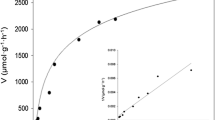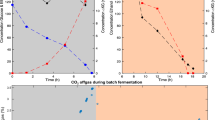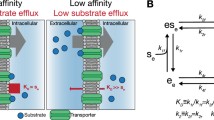Abstract
The steady-state residual glucose concentrations in aerobic chemostat cultures of Saccharomyces cerevisiae ATCC 4126, grown in a complex medium, increased sharply in the respiro-fermentative region, suggesting a large increase in the apparent ks value. By contrast, strain CBS 8066 exhibited much lower steady-state residual glucose concentrations in this region. Glucose transport assays were conducted with these strains to determine the relationship between transport kinetics and sugar assimilation. With strain CBS 8066, a high-affinity glucose uptake system was evident up to a dilution rate of 0.41 h−1, with a low-affinity uptake system and high residual glucose levels only evident at the higher dilution rates. With strain ATCC 4126, the high-affinity uptake system was present up to a dilution rate of about 0.38 h−1, but a low-affinity uptake system was discerned already from a dilution rate of 0.27 h−1, which coincided with the sharp increase in the residual glucose concentration. Neither of the above yeast strains had an absolute vitamin requirement for aerobic growth. Nevertheless, in the same medium supplemented with vitamins, no low-affinity uptake system was evident in cells of strain ATCC 4126 even at high dilution rates and the steady-state residual glucose concentration was much lower. The shift in the relative proportions of the high and low-affinity uptake systems of strain ATCC 4126, which might have been mediated by an inositol deficiency through its effect on the cell membrane, may offer an explanation for the unusually high steady-state residual glucose concentrations observed at dilution rates above 52% of the wash-out dilution rate.
Similar content being viewed by others
References
Bisson LF, Coons DM, Kruckeberg AL & Lewis DA (1993) Yeast sugar transporters. Crit. Rev. Biochem. Molecular. Biol. 28: 259–308
Bisson LF & Fraenkel DG (1983) Involvement of kinases in glucose and fructose uptake by Saccharomyces cerevisiae. Proc. Natl. Acad. Sci. USA 80: 1730–1734
Bisson LF & Fraenkel DG (1984) Expression of kinase-dependent glucose uptake in Saccharomyces cerevisiae. J. Bacteriol. 159: 1013–1017
Boles E & Hollenberg CP (1997) The molecular genetics of hexose transport in yeasts. FEMS Microbiol. Rev. 21: 85–111
Busturia A & Lagunas R (1986) Catabolite inactivation of the glucose transport system in Saccharomyces cerevisiae. J. Gen. Microbiol.132: 379–385
Chi Z, Kohlwein SD & Paltauf F (1999) Role of phosphatidylinositol (PI) in ethanol production and ethanol tolerance by a high ethanol producing yeast. J. Ind. Microbiol. Biotechnol. 22: 58–63
Cysewski GR & Wilke CR (1976) Utilization of cellulosic materials through enzymatic hydrolysis. I. Fermentation of hydrolysate to ethanol and single-cell protein. Biotechnol. Bioeng. 18: 1297–1313
De Kock SH, du Preez JC & Kilian SG (2000a) Anomalies in the growth kinetics of Saccharomyces cerevisiae strains in aerobic chemostat culture. J. Ind. Microbiol. Biotechnol. 24: 231–236
De Kock SH, du Preez JC & Kilian SG (2000b) The effect of vitamins and amino acids on glucose uptake in aerobic chemostat cultures of three Saccharomyces cerevisiae strains. System. Appl. Microbiol. 23: 41–46
Diderich JA, Schepper M, van Hoek P, Luttik MAH, van Dijken JP, Pronk JT, Klaassen P, Boelens HFM, de Mattos MJT, van Dam K & Kruckeberg AL (1999) Glucose uptake kinetics and transcription of HXT genes in chemostat cultures of Saccharomyces cerevisiae. J. Biol. Chem. 274: 15350–15359
Du Preez JC & van der Walt JP (1983) Fermentation of D-xylose to ethanol by a strain of Candida shehatae. Biotechnol. Lett. 5: 357–362
Gamo FJ, Moreno E & Lagunas R (1995) The low-affinity component of glucose transport system in Saccharomyces cerevisiae is not due to passive diffusion. Yeast 11: 1393–1398
Ghose TK & Tyagi RD (1979) Rapid ethanol fermentation of cellulose hydrolysate. I. Batch versus continuous systems. Biotechnol. Bioeng.21: 1387–1400
Haraldson A & Björling T (1981) Yeast strains for concentrated substrates. Eur. J. Appl. Microbiol. Biotechnol. 13: 34–38
Hoppe GK & Hansford GS (1982) Ethanol inhibition of continuous anaerobic yeast growth. Biotechnol. Lett. 4: 39–44
Krampe S & Boles E (1999) Catabolite-inactivation of the highaffinity hexose transporters Hxt6 and Hxt7 of Saccharomyces cerevisiae occurs in the vacuole after internalization by endocytosis. In: Current Genetics Abstracts, 19th International conference on yeast genetics and molecular biology 1999, Italy.
Lagunas R (1993) Sugar transport in Saccharomyces cerevisiae. FEMS Microbiol. Rev. 104: 229–242
McDowell HE, Walker T, Hajduch E, Christie G, Batty IH, Downes CP & Hundal HS (1997) Inositol phospholipid 3-kinase is activated by cellular stress but is not required for the stress-induced activation of glucose transport in L6 rat skeletal muscle cells. Eur. J. Biochem. 247: 306–313
Meijer MMC, Boonstra J, Verkleij AJ & Verrips CT (1996) Kinetic analysis of hexose uptake in Saccharomyces cerevisiae cultivated in continuous culture. Biochim et Biophys. Acta 1277: 209–216
Motulsky H (1999) Analysing data with GraphPad Prism (pp 225–232). GraphPad Software Inc., San Diego
Muller G, Wied S, Crecelius A, Kessler A & Eckel J (1997) Phosphoinositolglycan-peptides from yeast potently induce metabolic insulin actions in isolated rate adipocytes, cardiomyocytes, and diaphragms. Endocrinology 138: 3459–3475
Özcan S & Johnston M (1995) Three different regulatory mechanisms enable yeast hexose transporter (HXT) genes to be induced by different levels of glucose. Mol. Cell. Biol. 15: 1564–1572
Postma E, Scheffers WA & van Dijken JP (1989) Kinetics of growth and glucose transport in glucose-limited chemostat cultures of Saccharomyces cerevisiae CBS 8066. Yeast 5: 159–165
Ramos J, Szkutnicka K & Cirillo VP (1988) Relationship between low-and high-affinity glucose transport systems of Saccharomyces cerevisiae. J. Bacteriol. 170: 5375–5377
Ratledge C & Evans CT (1989) Lipids and their metabolism. In: Rose AH & Harrison JS (Eds) The Yeasts, Vol 3 (pp 367–444). Academic Press, London
Reifenberger I, Boles E & Ciriacy M (1997) Kinetic characterization of individual hexose transporters of Saccharomyces cerevisiae and their relation to the triggering mechanisms of glucose repression. Eur. J. Biochem. 245: 324–333
Schulze U (1995) Anaerobic physiology of S. cerevisiae. Ph.D. thesis. Department of Biotechnology, Technical University of Denmark, Lyngby, Denmark
Teusink B, Diderich JA, van Westerhoff H, van Dam K & Walsh MC (1998) Intracellular glucose concentration in derepressed yeast cells consuming glucose is high enough to reduce the glucose transport rate by 50%. J. Bacteriol. 180: 556–562
Ulaszewski S, Woodward JR & Cirillo VP (1978) Membrane damage associated with inositol-less death in Saccharomyces cerevisiae. J. Bacteriol. 136: 49–54
van Urk H, Postma E, Scheffers WA & van Dijken JP (1989) Glucose transport in Crabtree-positive and Crabtree-negative yeasts. J. Gen. Microbiol. 135: 2399–2406
Walsh MC, Smits HP, Scholte M & van Dam K (1994) Affinity of glucose transport in Saccharomyces cerevisiae is modulated during growth of glucose. J. Bacteriol. 176: 953–958
Weusthuis RA, Pronk JT, van den Broek PJA & van Dijken JP (1994) Chemostat cultivation as a tool for studies on sugar transport in yeasts. Microbiol. Rev. 58: 616–630
Wieczorke R & Boles E (1999) A yeast strain deleted for 21 hexose transporter genes as a tool for the analysis of sugar transporters and the mechanisms of protein translocation to the plasma membrane. In: Current Genetics Abstracts, 19th International conference on yeast genetics and molecular biology 1999, Italy
Yarrow D (1998) Methods for the isolation, maintenance and identi-fication of yeasts. In: Kurtzman CP & Fell JW (Eds) The Yeasts, a Taxonomic Study, 4th Ed (pp 77–100). Elsevier, Amsterdam
Author information
Authors and Affiliations
Corresponding author
Rights and permissions
About this article
Cite this article
du Preez, J.C., de Kock, S.H., Kilian, S.G. et al. The relationship between transport kinetics and glucose uptake by Saccharomyces cerevisiae in aerobic chemostat cultures. Antonie Van Leeuwenhoek 77, 379–388 (2000). https://doi.org/10.1023/A:1002744100953
Issue Date:
DOI: https://doi.org/10.1023/A:1002744100953




